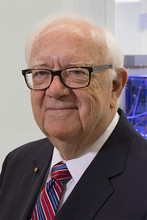R&D: Smallest-Ever Magnetic Vortexes Mark Step Toward New Digital Memory
Effect of size confinement on skyrmionic properties of MnSi nanomagnets
This is a Press Release edited by StorageNewsletter.com on July 16, 2018 at 2:18 pmBy Scott Schrage | University Communication, University of Nebraska–Lincoln
By twisting magnetism into record-small spirals, University of Nebraska-Lincoln physicists are speeding efforts to turn the digital equivalent of memory lane into a memory racetrack that could save energy and space in next-generation electronics.
An illustration of the magnetic vortex, known as a skyrmion, that could star
in the next generation of digital memory. Each arrow indicates
the direction of the magnetic axis in an individual atom.
(Nanoscale / Royal Society of Chemistry)
Magnetic materials contain atoms that act like miniature versions of a classic bar magnet, with each featuring a north and south pole. In the materials that exhibit the strongest magnetic fields – the so-called ferromagnets that transform a refrigerator into a photo gallery, for instance – the poles of those atoms all point in the same direction.
But that orderly arrangement can get disrupted by a skyrmion (SKUR’-mee-ahn): a set of atoms whose poles tilt further and further away from the magnetic axis as they approach the skyrmion’s center, with the atom at its core pointing in the opposite direction of that axis.
David Sellmyer
 Researchers had previously created skyrmions with a diameter of about 50 nanometers – roughly 2,000 times thinner than a human hair – in a ferromagnetic material called manganese monosilicide. But a new study led by David Sellmyer and Balamurugan Balasubramanian, Nebraska, has reported the formation of skyrmions just 13 nanometers wide – what seems to be the smallest possible size in the material.
Researchers had previously created skyrmions with a diameter of about 50 nanometers – roughly 2,000 times thinner than a human hair – in a ferromagnetic material called manganese monosilicide. But a new study led by David Sellmyer and Balamurugan Balasubramanian, Nebraska, has reported the formation of skyrmions just 13 nanometers wide – what seems to be the smallest possible size in the material.
That miniaturization matters, Sellmyer said, if the ‘interesting magnetic structures’ are to fulfill their promise as a next-generation form of digital memory.
“One of the biggest limitations has been the diameter of these things,” said Sellmyer, George Holmes University distinguished professor of physics and astronomy. “This discovery is an important step toward exploiting them for real-world applications.”
Digital data storage traditionally exists as separate batches of negatively and positively polarized atoms that represent the 1s and 0s, or bits, of binary code. Because creating and moving a skyrmion demands far less energy than aligning those polarized groups of atoms, researchers see the magnetic spiral as an appealing alternative for digital storage. Under that scenario, the different magnetic signatures produced in the presence and absence of skyrmions would represent the binary bits of data.
“In the past several decades, the density of data storage has gone through the roof,” said Sellmyer, who directs the Nebraska Center for Materials and Nanoscience. “Places all over the country are building these cloud-storage sites. The amount of information that’s getting stored – and the power consumed by these data centers – is getting so high that you practically have to imagine a power plant next to them. So we need faster and much lower-energy data storage.”
Before that can happen, Sellmyer said, researchers need to shrink skyrmions down to a scale that at least rivals existing digital memory formats. Though 13 nanometers is plenty small, the team managed to create such a tiny skyrmion only at extremely low temperatures – minus-382°F being the highest. Finding a method or material that can support minuscule skyrmions at room temperature remains a major goal, he said.
Balamurugan Balasubramanian
 Achieving the feat would also allow researchers to experiment with memory racetracks: nanoscopic stripes that could transport the magnetic vortexes from one group of atoms to another when propelled by an electric current. By bringing those bits to a data reader/writer rather than vice versa, racetrack designs could increase processing speeds and extend the life spans of hard drives.
Achieving the feat would also allow researchers to experiment with memory racetracks: nanoscopic stripes that could transport the magnetic vortexes from one group of atoms to another when propelled by an electric current. By bringing those bits to a data reader/writer rather than vice versa, racetrack designs could increase processing speeds and extend the life spans of hard drives.
“A (conventional) hard drive has a disc whirling around with many moving parts, and there are crashes,” Sellmyer said. “This new kind of racetrack-based technology will be a big improvement in that components are not going to wear out, and you use less power.”
“A lot of work has to be done in terms of seeing whether one could make, for example, a 20-nanometer-wide stripe and move the skyrmions along it. But that’s the overarching goal of this work.”
The team detailed its findings in the journal Nanoscale, which highlighted the research on its back cover. Sellmyer and Balasubramanian authored the study with Ralph Skomski and Shah Valloppilly, Nebraska Center for Materials and Nanoscience, along with Bhaskar Das, doctoral alumnus of Nebraska now at the Ames Laboratory; Pinaki Mukherjee, a former Nebraska postdoctoral researcher now at Rutgers University; and George Hadjipanayis from the University of Delaware.
The U.S. Department of Energy, National Science Foundation and Nebraska Research Initiative supported the team’s work.
Article: Effect of size confinement on skyrmionic properties of MnSi nanomagnets
Nanoscale has published an article written by Bhaskar Das, Balamurugan Balasubramanian, Ralph Skomski, Pinaki Mukherjee, Nebraska Center for Materials and Nanoscience, University of Nebraska, Lincoln, USA, and Department of Physics and Astronomy, University of Nebraska, Lincoln, USA, Shah R. Valloppill, Nebraska Center for Materials and Nanoscience, University of Nebraska, Lincoln, USA, George C. Hadjipanayis, Department of Physics and Astronomy, University of Delaware, Newark, USA, and David J. Sellmyer, Nebraska Center for Materials and Nanoscience, University of Nebraska, Lincoln, USA, and Department of Physics and Astronomy, University of Nebraska, Lincoln, USA.
Abstract: “Bulk magnetic materials with the noncentrosymmetric cubic B20 structure are fascinating due to skyrmion spin structures associated with Dzyaloshinskii–Moriya interactions, but the size of skyrmions are generally larger than 50 nm. The control of such spin structures in the 10 nm size ranges is essential to explore them for spintronics, ultra-high-density magnetic recording, and other applications. In this study, we have fabricated MnSi nanoparticles with average sizes of 9.7, 13.1 and 17.7 nm and investigated their structural and magnetic properties. X-ray diffraction and transmission electron microscope studies show that the MnSi nanoparticles crystallize in the cubic B20 structure. Field-dependent dc susceptibility data of the MnSi samples with average particle sizes of 17.7 and 13.1 nm show anomalies in limited field (about 25–400 Oe) and temperature (25 K–43 K) ranges. These features are similar to the signature of the skyrmion-like spin structures observed below the Curie temperature of MnSi. Our results also show that this anomalous behavior is size-dependent and suppressed in the smallest nanoparticles (9.7 nm), and this suppression is interpreted as a confinement effect that leads to a truncation of the skyrmion structure.“















 Subscribe to our free daily newsletter
Subscribe to our free daily newsletter

